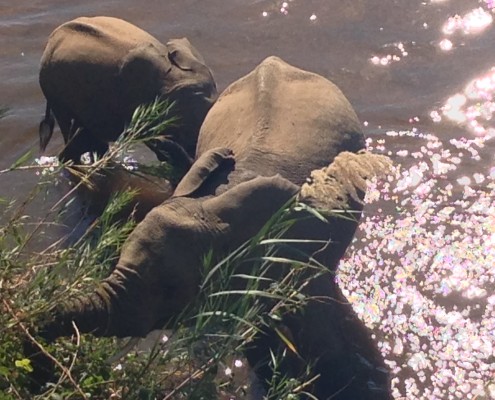Animals to look out for in the rest camps of Kruger National Park on safari
Elephants
On your visit to the Kruger National park you will find quite a variety of animals right at your doorstep. Below you will see only a few which you will often come across in the Kruger National Park rest camps. The Kruger National Park is popular for it’s big variety of wildlife and different animal types, and offers such a fortunate experience as some of these animals move around you at your accommodation, whilst having lunch at a restaurant or visiting the shop in the Kruger National Park. You get opportunity to see wildlife close-up in the Kruger National Park, not only by partaking in game drives or activities, but also through moving around within your rest camp. Elephants often eat Marula Fruit next to rivers, while you are dining at the restaurants of the rest camps.
As one of the Big 5, Elephants are regularly spotted in the Kruger National Park. Elephants can live up to 70 years in the wild and are herbivorous. They can also live in different habitats, including deserts and forests and normally found close to water. There are two types of Elephants, African Elephant and Asian Elephant. The Elephant species found in the Kruger National Park is the African Bush Elephant (Loxodonta africana) and weighs up to 7 tonnes and reaches a height of 3.3 meters to the shoulder.
Bush Babies
There are two types of Bushbabies (Galagos) found in Kruger National Park, which are the Lesser Bushbaby and Thick-tailed Bushbaby. The Lesser Bushbaby (Galago moholi), tree-dwelling and active by night, they can do remarkable distance between trees. When walking on the ground they can either walk on their hind legs or all four legs. Their diet consist of tree gum and insects and eating fruit is likely recorded. The Thick-Tailed Bushbaby (as seen in the picture above) is a nocturnal with child-like cries, this is also where the English vernacular name originated due to it’s diet and larger body size and is the most social of all Bushbabies. At dusk groups disperse to feed alone while foraging for insects, but they will congregate with members of other groups at well-established gum licks and in fruiting trees.
Warthogs
Vervet Monkeys
The Warthog (Phacochoerus africanus) found in the Kruger National Park are day animals and mostly spend their time looking for food and are normally found in family groups. Warthogs have the peculiar habit of kneeling on the front knees while feeding and foraging in a localised area. They shelter in burrows at night, which they enter tail first. Socially, three main groups are encountered, namely solitary boars, bachelor groups and matriarchal groups. Its diet is omnivorous, composed of grasses, roots, berries and other fruits, bark, fungi, insects, eggs and carrion.
Vervet Monkeys are commonly found in the Kruger National Park as well as surrounding areas. Also known as (Cercopithecus Aethiops). The vervet monkey is classified as a medium to large monkey. Different types of vervets vary in colour, but generally the body is a greenish olive or silvery grey.
Size: 18 to 26 inches.
Weight: Between 6 and 17 pounds.
Diet – Omnivore.
Fruit Bats
Glossy Starling
There are three species of Fruit Bats found in the Kruger National Park and are quite large and can weigh up to 1.5 kilograms. They do not have a tail of a very short tail. Fruit Bats require habitat where fruit trees bare fruit all year long.
The three species found in the Kruger National Park are:
- Peter’s Epaulette Fruit Bat (Epomophorus crypturus)
- Wahlberg’s Epaulette Fruit Bat (Epomophorus wahlbergi)
- Egyptian Fruit Bat (Rousettus aegyptiacus)
In the Kruger National Park there are four species of glossy blue starlings, namely Cape Glossy, Greater Blue-eared, Burchell’s and Meve’s Starlings. These birds are actually quite commonly found especially in the Kruger National Park rest camp. You will also notice that they normally surround areas such as restaurants and picnic spots in the Kruger National Park, to try and source any left over food.
Blue-Headed Tree Agama
The Blue-headed Tree Agama is also known as the Southern Tree Agama and are very commonly found in different habitats and you will most definitely come across this beautiful lizard in the Kruger National Park. Their diet mostly consist of ants and termites, although they also eat other insects. The female will lay up to 14 eggs, normally in a hole in the ground which they cover. Be on the lookout in the Kruger National park, in trees or on the ground as you will definitely spot them aroundd your rest camp.


